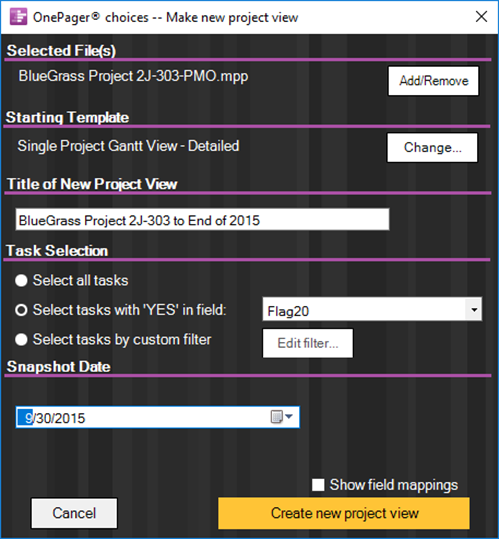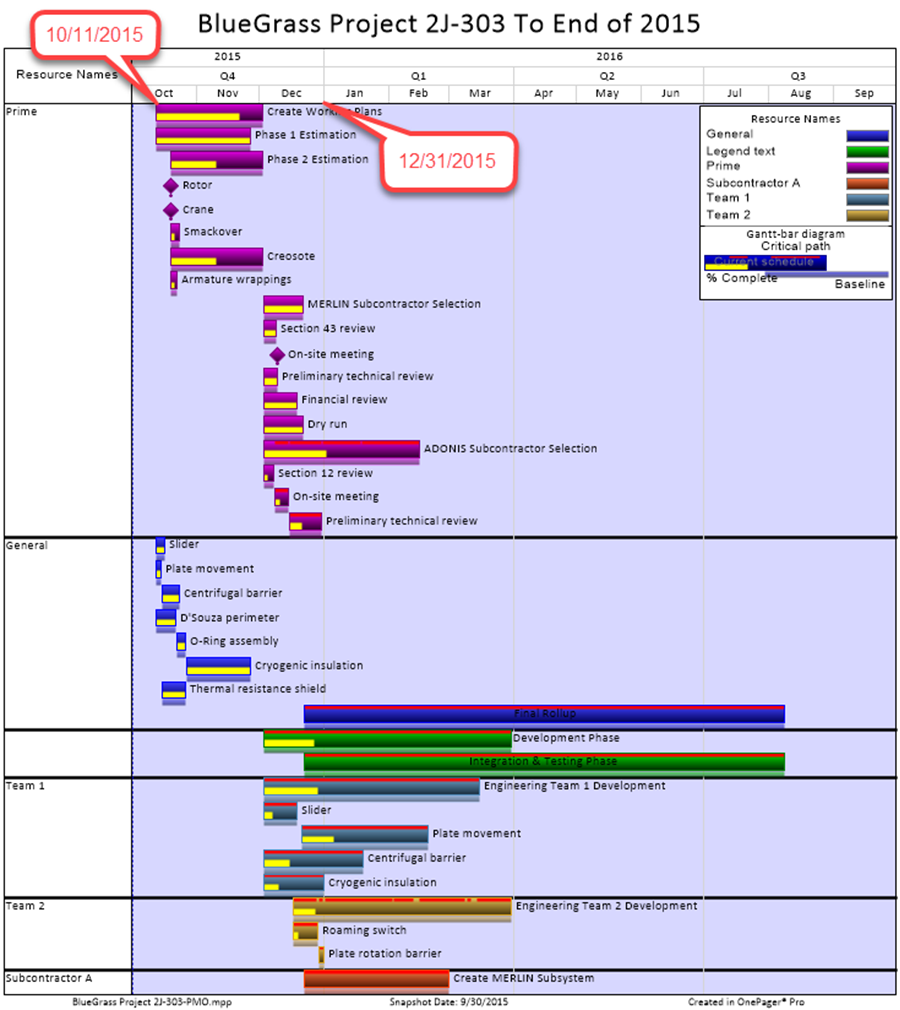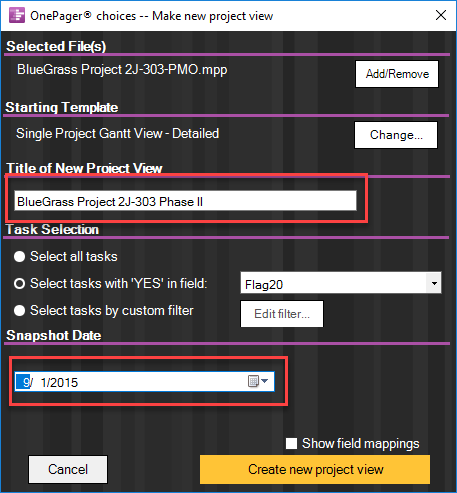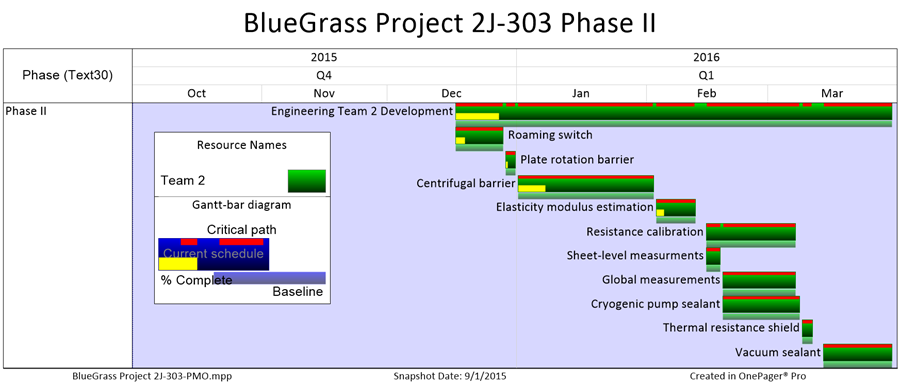Difference between revisions of "Conditional Import for OnePager Pro/Express Version 6.0"
(→Related Links:) |
|||
| Line 74: | Line 74: | ||
5) Since '''OPP''' was told to generate the legend using the '''Resource Names''' column from the Microsoft Project source plan, you see that only one phase name is displayed. '''Team 2''' is shown in the legend as the only resource name participating in '''Phase II''' of the project. Using '''Conditional Import''' first overcomes any difficulty dealing with a Read-only file and, second, allows you to '''focus''' on the second phase of the project to see the details in the plan. In this case, the resources assigned. Again, '''Conditional Import''' becomes an '''analysis''' aid as well as a '''presentation''' aid. | 5) Since '''OPP''' was told to generate the legend using the '''Resource Names''' column from the Microsoft Project source plan, you see that only one phase name is displayed. '''Team 2''' is shown in the legend as the only resource name participating in '''Phase II''' of the project. Using '''Conditional Import''' first overcomes any difficulty dealing with a Read-only file and, second, allows you to '''focus''' on the second phase of the project to see the details in the plan. In this case, the resources assigned. Again, '''Conditional Import''' becomes an '''analysis''' aid as well as a '''presentation''' aid. | ||
| − | |||
| − | |||
| − | |||
| − | |||
| − | |||
| − | |||
| − | |||
| − | |||
| − | |||
| − | |||
| − | |||
| − | |||
| − | |||
| − | |||
| − | |||
| − | |||
| − | |||
| − | |||
| − | |||
| − | |||
| − | |||
| − | |||
| − | |||
| − | |||
| − | |||
| − | |||
| − | |||
| − | |||
| − | |||
| − | |||
| − | |||
| − | |||
| − | |||
| − | |||
| − | |||
| − | |||
| − | |||
| − | |||
| − | |||
| − | |||
| − | |||
| − | |||
| − | |||
| − | |||
| − | |||
| − | |||
| − | |||
| − | |||
| − | |||
| − | |||
| − | |||
| − | |||
| − | |||
| − | |||
| − | |||
| − | |||
| − | |||
| − | |||
| − | |||
| − | |||
| − | |||
==Related Links:== | ==Related Links:== | ||
Revision as of 16:02, 27 December 2016
Contents
About Conditional Import for OnePager (PE60-0_4_1_1-11112016)
In OPP and OPX version 6.0, the capability for you to control the import of rows from your source plan is made even more flexible with the addition of new Conditional Import capabilities. Here we overview some situations you may have encountered in the past with OnePager that can be facilitated better with Conditional Import.
When a Flag Field Isn’t Sufficient
1) There are occasions where you would like to import a source plan row but only when the contents of a specified column holds a desired value or range of values for that row. In this case, using a flag field may not be flexible enough or may be too time consuming to use.
2) Suppose you want to include source plan rows where task/milestone Start dates are greater than a specified date. Prior to OnePager version 6.0 you would have to manually locate and modify the flag cell contents for those rows meeting the desired condition before importing data to OnePager. With version 6.0 you can clearly specify, in a Conditional Import rule, defined before the import process begins, the conditions that meet any logical combination of criteria WITHOUT making modifications to the source plan. Here’s how it might work:
- a) We’ll use the BlueGrass Project 2J-303 Microsoft Project source plan as an example. Recall that the column headers look something like this:

- b) For this example you only want to import tasks/milestones that have a Start date greater than 10/11/2015 but less than 12/31/2015. You can do this by first launching Microsoft Project with the source plan loaded as shown above. Next, launch OPP version 6.0 from the Microsoft Project tool bar as you normally do and click the NEW button option. When this is done the following OnePager Choices form appears:
- c) The OnePager choices (OPC) form above has an additional radio button in the Task Selection group, Select tasks by custom filter and a new button called Edit filter…. Before clicking the Select tasks by customer filter button, update the project view name and snapshot date such that the OPC form looks like this:

- d) Now, click the Select tasks by custom filter button. When you do, a blank Custom Import Rules form will appear as show below:
- e) You can now compose the two rules needed to import rows that have Start dates greater than 10/11/2015 but less than 12/31/2015. When you do this, the Conditional Import Rules form will look like this:
- f) Note that the All of the following rules are true radio button is selected so that the two rules are essentially an AND operation. When you click OK on the form, it will disappear and you will be back at the OPC form once more. At this point. click the Create new project view button and OPP will create the project view that looks like this:

- g) In the project view above, there are tasks that extend beyond 12/31/2015 but there are no tasks that Start on or after 12/31/2015. Similarly, there are no tasks that Start before 10/11/2015.
- h) When the project view is saved, the Conditional Import rules are saved as well and will be used to control the import for subsequent snapshots. Further, in either this snapshot or subsequent ones, the Conditional Import rules can be edited (i.e., changed, added, or deleted). When such changes are made to the Conditional Import rules, the current new snapshot or the snapshot being replaced will be configured by the active set of Conditional Import rules. Finally, you can always revert to using flag columns or select All tasks for import.
- i) An important thing to remember is that the Conditional Import rules, like the use of a single flag column, applies to only the current snapshot. Therefore, changing the Conditional Import rules for a down timeline snapshot will NOT change the look for all previous snapshots unless further Conditional Import rules changes are specifically made for these snapshots via the REPLACE snapshot procedure.
3) Conditional Import is a powerful new capability that allows you to better control the content of your project views. Conditional Import also makes project views more useful in project schedule analysis presentations/discussions. As such, OnePager becomes not only a presentation tool but an addition to your suite of project schedule analysis tools.
When Microsoft Project Source Plans are Read-Only
4) Occasions may also arise where you are not able to modify a Microsoft Project source plan. For instance, with a read-only file you might be unable to add the required import control flag columns or be unable to change them. You would have to first import all rows and manually edit out or hide the unwanted row tasks/milestones after the project view is created. Again, version 6.0 allows you to specify import conditions that meet your needs, say, only the rows which correspond to a particular project Phase for which there are data already available in the plan’s source file. The example below will illustrate this:
- a) Consider the Microsoft Project source plan just below which has no flag field columns defined and happens to be Read-only:

- b) For the sake of this example, we will assume that Flag1 through Flag20 are not defined and have no data in the rows even if these columns are hidden in Microsoft Project. You need, again for illustration, something to control the import of rows. We’ll use the Phase column from the source plan which happens to be the Microsoft Project Text30 column.
- c) Following the same sequences as in the previous example, we’ll launch OPP from the Microsoft Project tool bar, select the NEW option from the OnePager Start form, and make project view name and snapshot date modifications to the OPC form as shown below:

- d) In the Microsoft Project source plan there are a total of six (6) possible Phase names. In this example, we’ll use Conditional Import to just build a project view showing Phase II task and milestones by creating a Conditional Import rule that looks like this:
- e) This simple Conditional Import rule gives you access to all the tasks associated with Phase II. So, click the OK button on the above form and then click the Create project view button on the OPC form to create the project view as shown below:

5) Since OPP was told to generate the legend using the Resource Names column from the Microsoft Project source plan, you see that only one phase name is displayed. Team 2 is shown in the legend as the only resource name participating in Phase II of the project. Using Conditional Import first overcomes any difficulty dealing with a Read-only file and, second, allows you to focus on the second phase of the project to see the details in the plan. In this case, the resources assigned. Again, Conditional Import becomes an analysis aid as well as a presentation aid.
Related Links:
Conditional Formatting (Portal) Point to Version 6.0 Later
Using the OnePager "Data" Tab's "Selected file(s)" Button
OnePager Express Import of Data from Microsoft Excel
Message to Assist with Setting Import Flags When No Data Are Imported
Understanding Project Views and Snapshots for OnePager Pro
Understanding Project Views and Snapshots for OnePager Express
(0.4.1.1-60)